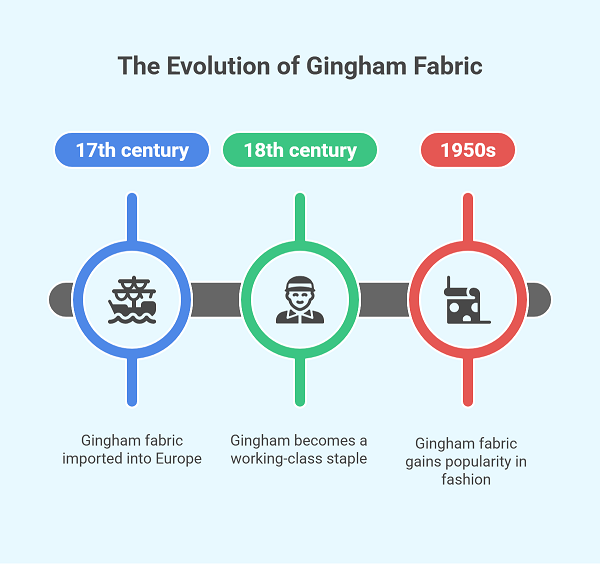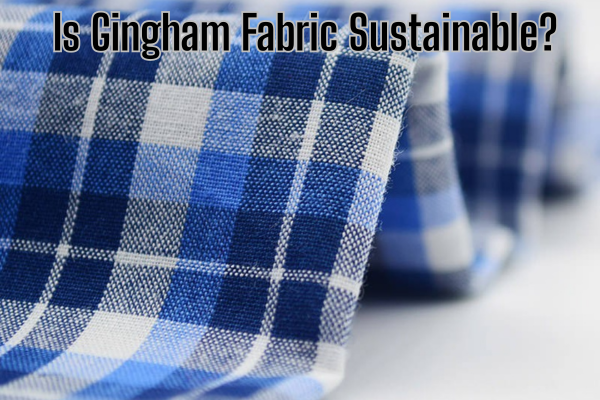What Exactly Is Gingham Fabric?
So, you’ve seen it in picnic blankets and summer shirts, but what is gingham fabric really?
Let’s get to the threads.
Table of Contents
Gingham fabric is a plain-woven cotton or cotton-blend textile known for its signature checkered pattern—typically in white and one bold color like red, blue, or green. This fabric isn’t printed. Nope. The checks come from dyed yarns woven in an over-under pattern, forming perfectly balanced squares.
Think of it like a chessboard, but friendlier.
Key Characteristics of Gingham Fabric
- Pattern Repeat: Usually small to medium checks (commonly 1/8″, 1/4″, or 1/2″).
- Weight: Light to medium weight; usually around 120–160 GSM.
- Composition: 100% cotton or cotton-polyester blends.
- Weave: Plain weave—basic but strong.
- Finish: Crisp, smooth, and slightly stiff.
A Quick History of Gingham Fabric
Let’s rewind a bit. The word gingham likely comes from the Malay word genggang, meaning striped. The fabric gained fame in the 17th century when it was imported into Europe—first striped, then checked.

By the 18th century, gingham fabric became a working-class staple in England and America. By the 1950s, thanks to movies and pin-up fashion, it got a flirty upgrade. Remember Dorothy’s blue gingham dress from The Wizard of Oz? Pure magic.
Today, it’s everywhere—from runway to rustic weddings.
Types of Gingham Fabric
Not all ginghams are created equal. Here’s a breakdown.

Classic Gingham
White base, plus one colored yarn (red, navy, black—your pick). Balanced checks.
Color-On-Color Gingham
Instead of a white base, it features two shades of the same color—like light and dark blue. Subtle and classy.
Embroidered Gingham
Gingham with embroidery? Yes, please. Used mostly in table linens and home décor.
Stretch Gingham
A blend of cotton and elastane. Think summer dresses that actually let you eat.
Common Uses of Gingham Fabric

Gingham isn’t just picnic material. It’s practical, fashionable, and surprisingly versatile.
Clothing
- Shirts: Lightweight this fabric is a menswear favorite.
- Dresses: Especially for summer—breezy, cute, and camera-ready.
- Skirts & Shorts: Casual but neat.
- Children’s Wear: Because checks hide chocolate stains well.
Home Décor
- Curtains: Gives that farmhouse vibe.
- Tablecloths & Napkins: Think BBQ season.
- Pillows: Adds texture without drama.
Accessories
- Headbands, scrunchies, tote bags.
Gingham is just that friendly fabric that fits in everywhere.
Pros and Cons of Gingham Fabric
Even your favorite cousin has flaws, right? Gingham too.
Pros
- Breathable: Great for hot weather.
- Affordable: Often cheaper than designer prints.
- Easy to Sew: Beginner-friendly.
- Timeless Style: Never really goes out of fashion.
Cons
- Wrinkles Easily: Especially the all-cotton versions.
- Shrinks: If not pre-washed.
- Pattern Matching: A sewing nightmare (but worth it).
How to Care for Gingham Fabric
Let’s keep those checks looking fresh.
Washing Tips
- Use cold water to avoid shrinkage.
- Mild detergent is best.
- Pre-wash before sewing to avoid surprises.
Drying and Ironing
- Tumble dry low or air dry flat.
- Iron while slightly damp for wrinkle-free finish.
Pro Tip: Always check if it’s a cotton-poly blend. Those are less high-maintenance.
Is Gingham Fabric Sustainable?
Good question.
If it’s made of 100% organic cotton, then yes—it’s eco-friendlier than synthetic textiles. However, if blended with polyester, it’s less biodegradable. Look for OEKO-TEX® or GOTS-certified options for ethical peace of mind.

Gingham Fabric in Today’s Fashion Industry
Here’s where it gets statistically interesting.
- 40% of spring/summer collections in 2024 featured gingham prints.
- 70% of fast-fashion brands use cotton-blend gingham.
- Gingham fabric is used in over 20 countries for school uniforms.
From Zara to Dior, gingham fabric is back in business and designers are giving it modern spins—oversized checks, neon shades, and even asymmetric tailoring.
Final Thoughts
Gingham fabric is more than a picnic cliché. It’s stylish, adaptable, and delightfully checkered. Whether you’re dressing up or decorating, it brings a playful yet polished charm that’s hard to beat.
Just remember—check the shrinkage, iron it right, and don’t be afraid to mix it with bold prints.
After all, fashion should be fun—even if you’re wearing squares.
FAQs About Gingham Fabric
1. Is gingham fabric breathable?
Yes, especially when made from 100% cotton. It’s perfect for summer wear.
2. What’s the difference between gingham and plaid?
Gingham has evenly spaced checks. Plaid is irregular, with varying line widths and colors.
3. Can gingham fabric be used for upholstery?
Yes, but only heavier-weight gingham. Lightweight types are better for clothing.
4. Does gingham always come in cotton?
Mostly, yes. But blends with polyester or elastane are also common for stretch and wrinkle resistance.
5. How do I stop gingham from shrinking?
Pre-wash the fabric in cold water and air dry it before cutting or sewing.
